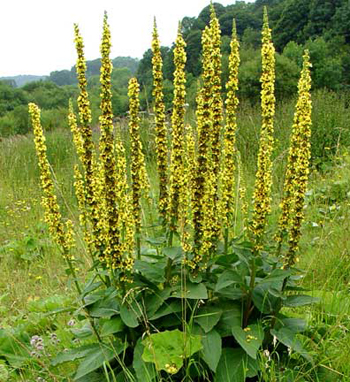Contents:
Common Names | Parts Usually Used | Plant(s) & Culture | Where Found | Medicinal Properties | Biochemical Information
Legends, Myths and Stories | Uses | Formulas or Dosages | Nutrient Content | How Sold | Warning | Bibliography
Scientific Names

- Agrimonia eupatoria L.
- Rosaceae
- Rose family
Common Names
- Burr marigold
- Cockleburr
- Church steeples
- Liverwort
- Sticklewort
Parts Usually Used
Dried whole plant before flowering, without the roots.
Back to Top
Description of Plant(s) and
Culture
A perennial plant with an erect stem (2-3 feet tall) with few branches, bearing pinnate leaves; and a terminal leafless flower spike, with many small, bright yellow, five-petalled flowers. The leaves narrow and about 5 inches long, have alternating pairs of large and small, saw-toothed leaflets. The whole plant is deep green and is covered with soft hairs. Fruits are upside-down cones, covered with hooked bristles on the top.
Golden star-shaped flowers have a mild apricot scent.
This is not the generally known troublesome cockleburr.
Agrimony grows best in light shade and dryish soil.
Agrimonia eupatoria is listed in early American herbals as Agrimonia gryposepala. Other varieties: Agrimonia parviflora, used interchangeably with A.eupatoria reported here; and A. Pilosa, thought to have antitumor activity. (Also called cucklbur is Xanthium strumarium)
Back to Top
Where Found
Grows abundantly by roadsides, at field edges, and on wasteland, and on the northern prairies and in Canada. A European native. Good rock garden plant.
Back to Top
Medicinal Properties
Astringent, antispasmodic, anti-inflammatory, diuretic, hemostatic (stops bleeding), analgesic, and promotes bile flow, tonic
Back to Top
Biochemical Information
Tannins, bitter glycosides, nicotinic acid amide, silicic acid, vitamins B and K, iron and essential oil.
Back to Top
Legends, Myths and Stories
Mainly valued today as a healing herb for the mucous membranes and for its astringent properties to stop bleeding. It has been used since Saxon times for wounds. In the 15th century, it was the prime ingredient of “arquebusade water”, a battlefield remedy for gunshot wounds. This healing power is now attributed to the herb’s high silica content. A related variety, (A. pilosa) known as xian he cao in China, is used in a similar way.
Back to Top
Uses
Good for dry coughs, where its effect is gently sedative. Some forms of rheumatism are helped. Considered a liver tonic.
Sometimes known as liverwort. Helps liver, spleen, kidney problems.
In France they drink agrimony as much for its flavor as for its medicinal virtues. Tea believed to be helpful in diarrhea, blood disorders, fevers, colds, sore throat, indigestion, mucus colitis, gout, hepatitis, gallbladder and gallstones, jaundice, dropsy, diarrhea, snakebites, pimples, indigestion, conjunctivitis, a gargle for sore throats and even worms.
A poultice made from fresh leaves and roots can be used to treat bruises, wounds, ulcers, draw out thorns and splinters, and sores.
It also may be used as a suppository, combining the extract with cocoa butter and inserting into the rectum for hemorrhoids, tapeworms, and diarrhea.
Back to Top
Formulas or Dosages
Prepare a standard infusion: drink a wineglassful 3 times per day. Mix an ounce of the dried plant with one pint of boiling water, sweeten with honey, and drink
Infusion: steep
Decoction: for external use, boil
Powder: take
Back to Top
Nutrient Content
Vitamins B and K, iron
Back to Top
How Sold
Tea
Back to Top
Warning
Because this herb is astringent, do not take if suffering from constipation.
Back to Top
Bibliography
![]() The Herb Book
The Herb Book, by John Lust, Bantam Books, 666 Fifth Avenue, New York, NY. copyright 1974.
![]() The Herbalist Almanac
The Herbalist Almanac, by Clarence Meyer, Meyerbooks, publisher, PO Box 427, Glenwood, Illinois 60425, copyright 1988, fifth printing, 1994
![]() Culpeper’s Complete Herbal & English Physician: Updated With 117 Modern Herbs
Culpeper’s Complete Herbal & English Physician: Updated With 117 Modern Herbs, by Nicholas Culpeper, Meyerbooks, publisher, PO Box 427, Glenwood, Illinois 60425, 1990, (reprint of 1814)
![]() The Complete Medicinal Herbal
The Complete Medicinal Herbal, by Penelope Ody, Dorling Kindersley, Inc, 232 Madison Avenue, New York, NY 10016, First American Edition, copyright 1993
![]() Eastern/Central Medicinal Plants
Eastern/Central Medicinal Plants, by Steven Foster and James A. Duke., Houghton Mifflin Company, 215 Park Avenue South, New York, NY 10000
Herbal Gardening, compiled by The Robison York State Herb Garden, Cornell Plantations, Matthaei Botanical Gardens of the University of Michigan, University of California Botanical Garden, Berkeley., Pantheon Books, Knopf Publishing Group, New York, 1994, first edition
 The Magic of Herbs
The Magic of Herbs, by David Conway, published by Jonathan Cape, Thirty Bedford Square, London, England. (Out of print)
![]() Indian Herbalogy of North America
Indian Herbalogy of North America, by Alma R. Hutchens, Shambala Publications, Inc., Horticultural Hall, 300 Massachusetts Avenue, Boston, Massachusetts 02115, 1973
![]() Planetary Herbology
Planetary Herbology, by Michael Tierra, C.A., N.D., O.M.D., Lotus Press, PO Box 325, Twin Lakes. WI 53181., Copyright 1988, published 1992
![]() American Folk Medicine
American Folk Medicine, by Clarence Meyer, Meyerbooks, publisher, PO Box 427, Glenwood, Illinois 60425, 1973
![]() Webster’s New World Dictionary
Webster’s New World Dictionary, Third College Edition, Victoria Neufeldt, Editor in Chief, New World Dictionaries: A Division of Simon & Schuster, Inc., 15 Columbus Circle, New York, NY 10023
 An Instant Guide to Medicinal Plants
An Instant Guide to Medicinal Plants, by Pamela Forey and Ruth Lindsay, Crescent Books (January 27, 1992).
 The Rodale Herb Book: How to Use, Grow, and Buy Nature’s Miracle Plants (An Organic gardening and farming book)
The Rodale Herb Book: How to Use, Grow, and Buy Nature’s Miracle Plants (An Organic gardening and farming book), edited by William H. Hylton, Rodale Press, Inc. Emmaus, PA, 18049., 1974
